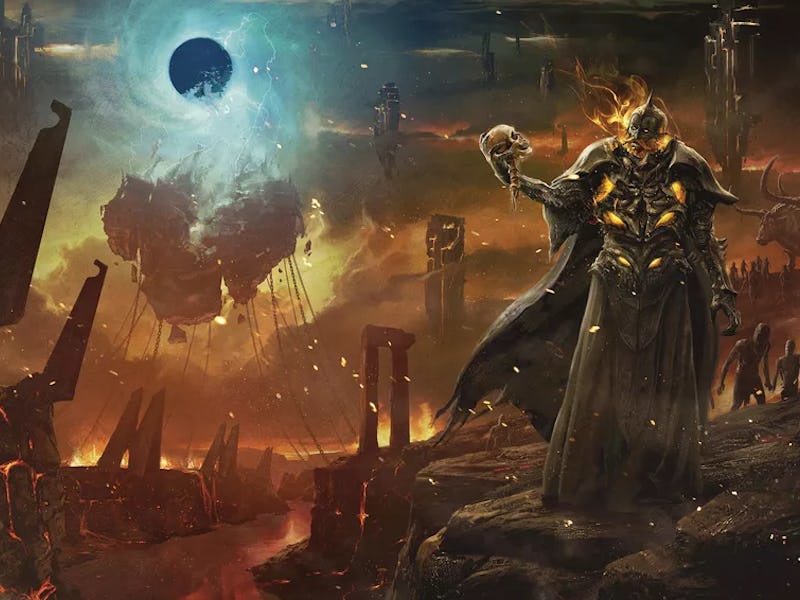'Descent Into Avernus' Review: D&D's Most Mature Campaign Yet Goes to Hell
This story set in Baldur's Gate goes far deeper than the first layer of Hell.

The longest-running table-top role-playing game ever, Dungeons & Dragons, is no stranger to horror and violence. The many planes and realms that different story campaigns visit feature terrifying abominations like Mind Flayers and Beholders, but seldom does a D&D story truly feel too horrifying for children to play. It’s always just fantasy, even when it veers into dark fantasy.
"A hellish experience in the most gnarly ways possible.
The Ravenloft setting used in Curse of Strahd explores Gothic horror in the traditional sense with vampires and ghouls, but the latest campaign adventure, Baldur’s Gate: Descent Into Avernus, feels like a brilliant meditation on the nature of evil itself that literally drags players down to hell. Adventuring into Hell should kind of be a miserable experience. Descent Into Avernus doesn’t forget this.
Light spoilers follow for Baldur’s Gate: Descent Into Avernus.
In D&D lore, Avernus is the first layer of the Nine Hells, and its holy city of Elturel has fallen into its dark depths in the midst of the Blood War between demons and devils. The archdevil Zariel, a warmongering fallen angel, leads the devils under the authority of the dark god Asmodeus. The players are citizens of Baldur’s Gate, a neighboring city on the verge of being swallowed up by Hell — unless somebody stops Zariel and destroys the magical Companion that holds Elturel in Avernus. This can be accomplished in any number of ways, from a traditional heroic adventure to something much more mischievous and corrupt as players strike bargains with various devils and deities.
Everyone talks up Descent Into Avernus as “Mad Max in Hell” because players acquire Infernal War Machine vehicles in Avernus that feel like they’ve roared right off the set of the Mad Max wasteland. This makes the new campaign feel like a spiritual successor to Ghosts of Saltmarsh from earlier this year, which introduced naval ship mechanics to D&D. But Descent Into Avernus is so much more than simply “Mad Max in Hell.”
This toy replica of an Infernal War Machine is scary enough.
If Curse of Strahd is Dracula in Dungeons & Dragons form, then Descent Into Avernus is some kind of twisted fusion of Castlevania, Constantine, and even Dante’s Inferno with a healthy does of — you guessed it — Mad Max. Plenty of D&D settings have scary monsters like vampires or demons, but not many of them instill a sense of fear, dread, and frustration quite like Descent Into Avernus. It’s literally a hellish experience in the most gnarly ways possible.
If I had kids and fulfilled my lifelong goal of DM-ing for them, this would be the last campaign setting I would choose. But will it be the next campaign I DM for my somewhat mature adult friends? That’s an absolute certainty.
Descent Into Avernus is constructed as a lengthy story campaign to take new Level 1 players all the way up to Level 13. Even from the foundation of character creation, things take a sinister twist in the form of a “Dark Secret” shared by the party that makes them all guilty of something. They may have been witnesses or willing participants in a murder, gotten themselves embroiled in a political conspiracy, stolen something of great value, or totally failed at some kind of coups to seize power.
No matter what a character’s alignment in the party, they’re still bound by some dark deed — and at least one living person knows. This functions as a unified flaw or bond in the group as a whole, and it’s one that makes even the do-gooder Lawful-Good Paladin or Cleric of the group corrupt from the start.
Even before players step foot in Hell, the city of Baldur’s Gate is already infected by a great evil. A pit fiend trapped in a magical shield whose influence has “contributed to the city’s moral decay for decades.” cultists murder people at random, and players are drafted into a group of corrupt local mercenaries to investigate. The locals panic as refugees from the fallen Elturel swarm Baldur’s Gate. And all this before players journey into Hell to figure out what’s causing all this chaos and death.
A painting by Wesley Burt in a devastated area of Avernus.
One of the most compelling early sections for any Dungeon Master of Descent Into Avernus includes role-playing notes for devils and “Life in the Nine Hells,” which describes the persistent state of misery for all beings in Avernus. Like something out of Dante’s Inferno, anyone in Avernus will constantly bemoan their current state of misfortune and hurl blame at everyone nearby. One optional mechanic is that while in Avernus, any natural 1 attack roll with a nonmagical weapon will cause that weapon to shatter.
Food and drink always tastes awful — unless you go to a special restaurant in Hell. DMs also have the option to reward particularly selfish behavior with a special kind of Inspiration. There’s even a suggestion to undercut any small victory a player might have with something irritating. Scoring a critical hit might result in the player getting stung by an infernal bug that poisons them, for instance. From a role-playing perspective, Descent Into Avernus is a treasure trove of strategies for putting players in compromising positions.
Like some of the greatest works of literature out there, Descent Into Avernus reminds us that the greatest forms of evil don’t come from some monstrous exterior threat. It’s the devils inside us that are the scariest of all. But this module also delivers on a complex adventure for any players who wants a more mature journey into Hell for their D&D experience.
Baldur’s Gate: Descent Into Avernus will be released on September 17, 2019.